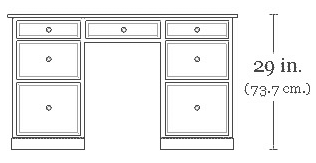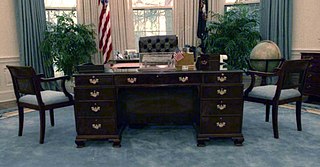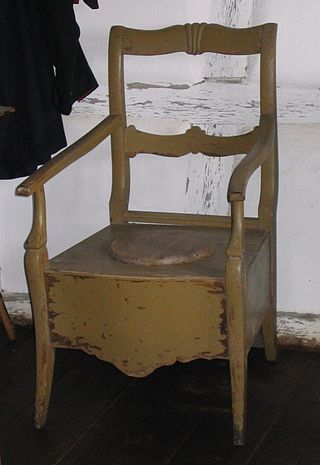
A pedestal desk or a tanker desk is usually a large, flat, free-standing desk made of a simple rectangular working surface resting on two pedestals or small cabinets of stacked drawers of one or two sizes, with plinths around the bases. Often, there is also a central large drawer above the legs and knees of the user. Sometimes, especially in the 19th century and modern examples, a "modesty panel" is placed in front, between the pedestals, to hide the legs and knees of the user from anyone else sitting or standing in front. This variation is sometimes called a "panel desk". The smaller and older pedestal desks with such a panel are sometimes called kneehole desks, they were intended for small spaces like boudoirs and were usually placed against a wall. The kneehole desks are also known as bureau tables.

A writing table has a series of drawers directly under the surface of the table, to contain writing implements, so that it may serve as a desk. Antique versions have the usual divisions for the inkwell, the blotter and the sand or powder tray in one of the drawers, and a surface covered with leather or some other material less hostile to the quill or the fountain pen than simple hard wood.

The fall-front desk is a desk with a main working surface that folds up to cover small shelves or drawers stacked in front of the user. As with its cousin the secretary desk, all working papers, documents and other items have to be stored before the desk is closed.

The slant-top desk, also called secretary desk, or more properly, a bureau, is a piece of writing furniture with a lid that closes at an angle and opens up as a writing surface. It can be considered related, in form, to the desk on a frame, which was a form of portable desk in earlier eras.

A partners desk, partner's desk or partners' desk is a mostly historical form of desk, a large pedestal desk designed and constructed for two users working while facing each other. The defining features of a partner's desk are a deep top, two sets of drawers, one at each end of the pedestal.

Bagatelle is a billiards-derived indoor table game, the object of which is to get a number of balls past wooden pins into holes that are guarded by wooden pegs; penalties are incurred if the pegs are knocked over. It probably developed from the table made with raised sides for trou madame, which was also played with ivory balls and continued to be popular into the later 19th century, after which it developed into bar billiards, with influences from the French/Belgian game billard russe. A bagatelle variant using fixed metal pins, billard japonais, eventually led to the development of pachinko and pinball.

A couch, also known as a sofa, settee, chesterfield, or davenport, is a cushioned item of furniture for seating multiple people. It is commonly found in the form of a bench with upholstered armrests and is often fitted with springs and tailored cushion and pillows. Although a couch is used primarily for seating, it may be used for sleeping. In homes, couches are normally put in the family room, living room, den, or lounge. They are sometimes also found in non-residential settings such as hotels, lobbies of commercial offices, waiting rooms, and bars. Couches can also vary in size, color, and design.

A commode is any of many pieces of furniture. The Oxford English Dictionary has multiple meanings of "commode". The first relevant definition reads: "A piece of furniture with drawers and shelves; in the bedroom, a sort of elaborate chest of drawers ; in the drawing room, a large kind of chiffonier." The drawing room is itself a term for a formal reception room, and a chiffonier is, in this sense, a small sideboard dating from the early 19th century.

An ottoman is a piece of furniture. Generally ottomans have neither backs nor arms. They may be an upholstered low couch or a smaller cushioned seat used as a table, stool or footstool. The seat may have hinges and form a lid for the inside hollow, which can be used for storage of linen, magazines or other items, making it a form of storage furniture. The smaller version is usually placed near to an armchair or sofa as part of living room decor or may be used as a fireside seat.

A table is an item of furniture with a raised flat top and is supported most commonly by 1 to 4 legs. It is used as a surface for working at, eating from or on which to place things. Some common types of tables are the dining room tables, which are used for seated persons to eat meals; the coffee table, which is a low table used in living rooms to display items or serve refreshments; and the bedside table, which is commonly used to place an alarm clock and a lamp. There are also a range of specialized types of tables, such as drafting tables, used for doing architectural drawings, and sewing tables.

A tea caddy is a box, jar, canister, or other receptacle used to store tea. When first introduced to Europe from Asia, tea was extremely expensive, and kept under lock and key. The containers used were often expensive and decorative, to fit in with the rest of a drawing-room or other reception room. Hot water was carried up from the kitchen, and the tea made by the mistress of the house, or under her supervision.

A lowboy is an American collectors term for one type of dressing table. It is a small table with one or two rows of drawers, so called in contradistinction to the tallboy or highboy chest of drawers.

A credenza is a dining room sideboard or display cabinet, usually made of burnished and polished wood and decorated with marquetry. The top would often be made of marble, or another decorative liquid- and heat-resistant stone.

A caddy spoon is a spoon used for measuring out tea in the form of dried tea leaves. Traditionally made of silver, they became very popular at the end of the 18th century, when this relatively inexpensive utensil can be found in practically any middle class household. Tea was sometimes stored in elaborate boxes or containers called tea caddies, and these spoons were made to be used with such containers. The caddy spoons went out of fashion in the early 20th century.

A close stool was an early type of portable toilet, made in the shape of a cabinet or box at sitting height with an opening in the top. The external structure contained a pewter or earthenware chamberpot to receive the user's excrement and urine when they sat on it; this was normally covered (closed) by a folding lid. "Stool" has two relevant meanings: as a type of seat and as human feces. Close stools were used from the Middle Ages until the introduction of the indoor flush toilet.

A Tip-top table is a folding table with the tabletop hinged so it can be placed into a vertical position when not used to save space. It is also called tilt-top table, tip table, snap table some variations are known as tea table, loo table. These multi-purpose tables were historically used for playing games, drinking tea or spirits, reading and writing, and sewing. The tables were popular among both elite and middle-class households in Britain and the USA in the 18th and 19th centuries. They became collector's items early in the 20th century.

In structural engineering, a trestle support is a structural element with rigid beams forming the equal sides of two parallel isosceles triangles, joined at their apices by a plank or beam. Sometimes additional rungs are stretched between the two beams. A pair of trestle legs can support one or several boards or planks, forming a trestle table or trestle desk. A network of trestle supports can serve as the framework for a trestle bridge, and a trestle of appropriate size to hold wood for sawing is known as a sawhorse.

A corner chair is a chair design with a four-corner seat arranged in a way that one corner, sometimes rounded, frequently with a cabriole leg, is positioned in front while the rounded or angled backrest is aligned with the two back sides of the seat.

The dressing table is a table specifically designed for performing one's toilette, intended for a bedroom or a boudoir.

Nest of tables is a set of few tables with progressively smaller heights and frames, so that they can be stacked when not in use. A smaller table slides inside the frame of a larger one until it engages the edge of the back frame.




















